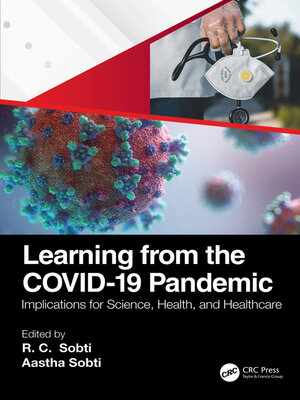Learning from the COVID-19 Pandemic
ebook ∣ Implications for Science, Health, and Healthcare
By RC Sobti

Sign up to save your library
With an OverDrive account, you can save your favorite libraries for at-a-glance information about availability. Find out more about OverDrive accounts.
Find this title in Libby, the library reading app by OverDrive.



Search for a digital library with this title
Title found at these libraries:
| Library Name | Distance |
|---|---|
| Loading... |
COVID-19 was first identified in Wuhan City in December 2019 and spread throughout Hubei Province and other parts of China. After causing significant morbidity and mortality in China, by February 2020, it had spread to numerous other countries, infecting millions of people and causing a large number of deaths across the world.
The COVID-19 pandemic put a burden on almost all areas of the world including healthcare systems, education, industry, travel, etc. The pandemic revealed the vulnerability of the world's healthcare systems and affected healthcare personnel significantly. The virus is able to attack not only the respiratory tract, but almost all the organs including the brain. Impacts on gut biota have also been noticed. The virus has caused both morbidity and mortality in humans without any geographical, cultural, or religious barriers. The emergence of new variants due to mutations in the virus has aggravated the problem. While the delta variant brought a second wave and killed a large number of people due to various factors such as lowering of saturated oxygen in blood and other physiological emergencies, the omicron variant proved to be less lethal. Though the pandemic has subsided, the emergence of the subvariants BA1 and BA2 and now their hybrids has started to increase the number of cases at exponential levels and has forced new lockdown measures in places such as China. As the conditions laid down to combat the pandemic have been relaxed, the virus may reach other countries and cause additional countries to resort to lockdown again.
COVID-19 became the focus of the scientific community with the aim of developing new drugs, repurposing available drugs to be used against the virus, and developing a series of vaccines in a short time. The mild effect of omicron might have been due to the extensive vaccination programmes carried out in various countries. However, there is genuine fear that newly emerging variants may evade the immune system and cause damage to the body.
This book highlights the impact of COVID-19 on science, industry, and healthcare systems. The chapters included in the volume come from dedicated experts belonging to basic sciences, biotechnology, pharmaceutical sciences, and other fields of sciences. These include discussions on how the virus evolves and attacks various organs in the body. A separate chapter explains the emergence of various strains of virus. The preparedness of hospitals and healthcare workers as well as different agencies such as DRDO to face the challenges posed by virus is also discussed. The way scientists and technologists developed new techniques to detect and control the virus have also been highlighted including a chapter on the development of vaccines to control the pandemic.
This book is a key resource for students, teachers, medical personnel, administrators, and the public as a whole.







